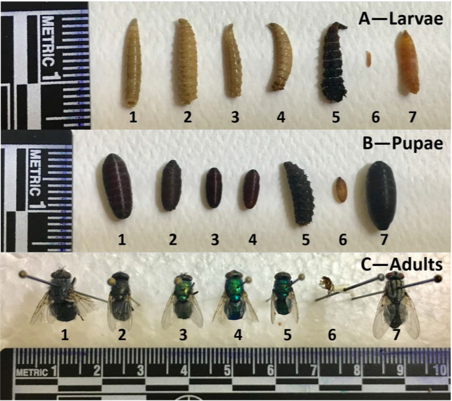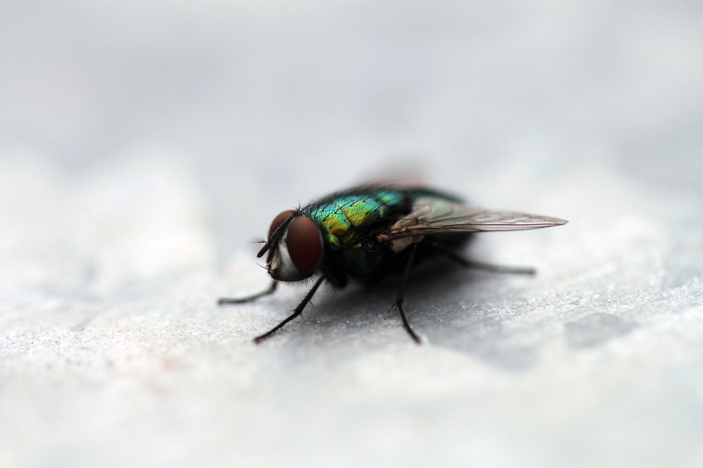Credit for featured photo: Mattx27 from flicker, available via Creative Commons
When a crime occurs, who are some of the first individuals at the scene? At the top of the list are paramedics, law enforcement, and crime scene investigators – but let’s not forget our most-important non-human first responder: insects.
When a person dies, insects arrive in a predictable manner to the body to lay their eggs. Members of the Calliphoridae family, commonly known as blowflies, are the first insects to arrive. These buzzing critters are of great relevance to forensic entomologists, who apply the study of insects to solving crime. When flies lay eggs on the body, they develop in a predictable manner under specific temperature and weather conditions. This information can be used to determine the interval of time for which the individual has been deceased, or the postmortem interval (PMI). Such information can be essential to building the timeline of the case and ruling out potential suspects.
Determining which species of blowflies that are present on a decomposing body can be a reliable determination of PMI, but it is by no means an easy feat. As shown in Figure 1, flies in different stages of development, whether larvae, pupae, or adult, are easy to identify; however, flies from the same family in the same life stage can be difficult to distinguish. Further, species are commonly identified by rearing or growing up the eggs laid on the body to adulthood and using observable physical characteristics, or phenotypic features, for identification. Fly rearing can be time consuming and may require an expert. Nutritional deficiencies or drugs in the corpse can also impact the larvae and pupae, complicating matters further. For these reasons, researchers have looked into other methods for identifying the species of flies present on a decomposing corpse.

Researchers from the Musah lab at the University at Albany have demonstrated that direct analysis in real time-high resolution mass spectroscopy (DART-HRMS), a more sensitive mass spectroscopy technique requiring little to no sample preparation, can measure the pupal casing along with advanced statistical analysis to identify fly species. However, a statistical model that could allow for the differentiation and identification of several species in various life stages needs to be developed in order for this method to be used practically. For this reason, Musah and colleagues aimed to create a model that can differentiate between different species of flies in ethanol suspensions at different life stages from their DART-HRMS spectrum.
Seven different species of blowflies were collected from the Manhattan, New York region and placed along with a pork liver inside of a colony cage (Figure 2). At the beginning of each life stage, a few insects were collected and suspended in ethanol. The DART-HRMS spectrum of the suspensions were then collected. Finally, the spectra were analyzed in MATLAB, a common statistical and coding program. First scientist wrote algorithms to select the variables most significant for species discrimination. Then, a subset of the data was used to create and train the model, as well as to evaluate how robust the model actually was, through blind cross validation with the same set of data. This is a common statistical method referred to as the “leave-one-out” method. The remaining data was used for external validation, where samples that were not used to build the model were assessed by the model.

For all three life stages, larvae, pupae, and adult, the research team observed spectral features that were unique to the different species. They additionally reported features that remained in all species, and others that were common in only a subset of species. These unique features allowed for the selection of discriminating variables and the creation of a successful species differentiation model. Scientists applied various models to discriminate between blowfly species in the training set data with 100%, 96%, and 93% accuracy for each life cycle stage. All three models discriminated between the different species with 100% accuracy for the external validation data set.
While these results are promising, the insect species analyzed in this study are primarily from Manhattan, New York. It is necessary to expand upon the current model to include insects from other regions. Such a comprehensive model would be better for practical use by forensic entomologists. It also allows for a more reliable measurement of PMI through the identification of the insects present on a corpse. This will improve law enforcement’s ability to determine when a crime occurred and construct a more accurate timeline for a case, making solving cases that much quicker and easier.
| Title | Direct Analysis in Real Time-Mass Spectrometry and Kohonen Artificial Neural Networks for Species Identification of Larva, Pupa and Adult Life Stages of Carrion Insects |
| Authors | Samira Beyramysoltan, Justine E. Giffen, Jennifer Y. Rosati, and Rabi A. Musah |
| Journal | Analytical Chemistry |
| Year | 2018 |
| Link | https://pubs.acs.org/doi/10.1021/acs.analchem.8b01704 |
| Citation | Beyramysoltan, Samira; Giffen, Justine E.; Rosati, Jennifer Y.; Musah, Rabi A. Direct Analysis in Real Time-Mass Spectrometry and Kohonen Artificial Neural Networks for Species Identification of Larva, Pupa and Adult Life Stages of Carrion Insects. Anal. Chem. 2018, 90, 9206-9217. |

One thought on “Identifying forensic science’s “first responder”, the blowfly”